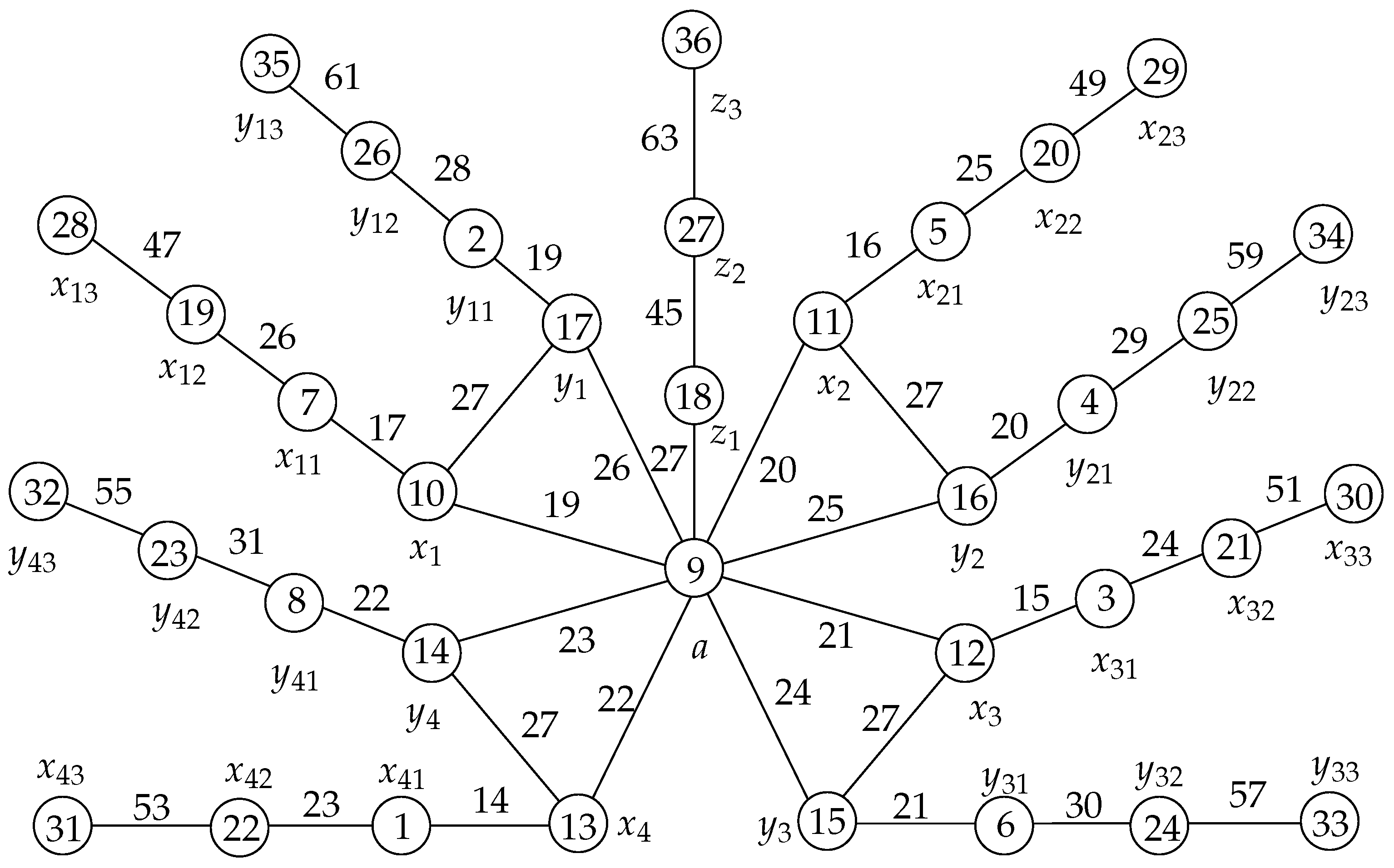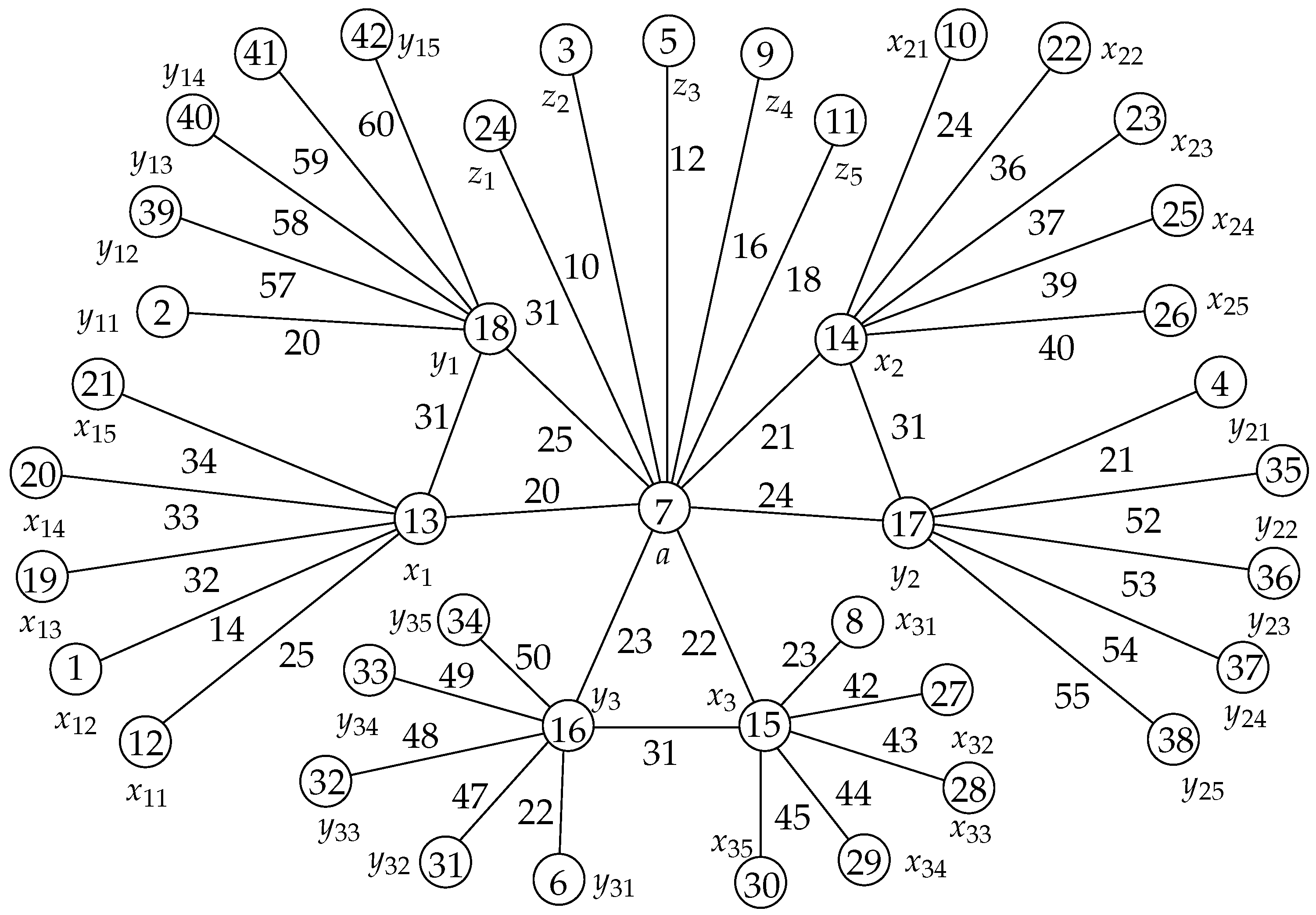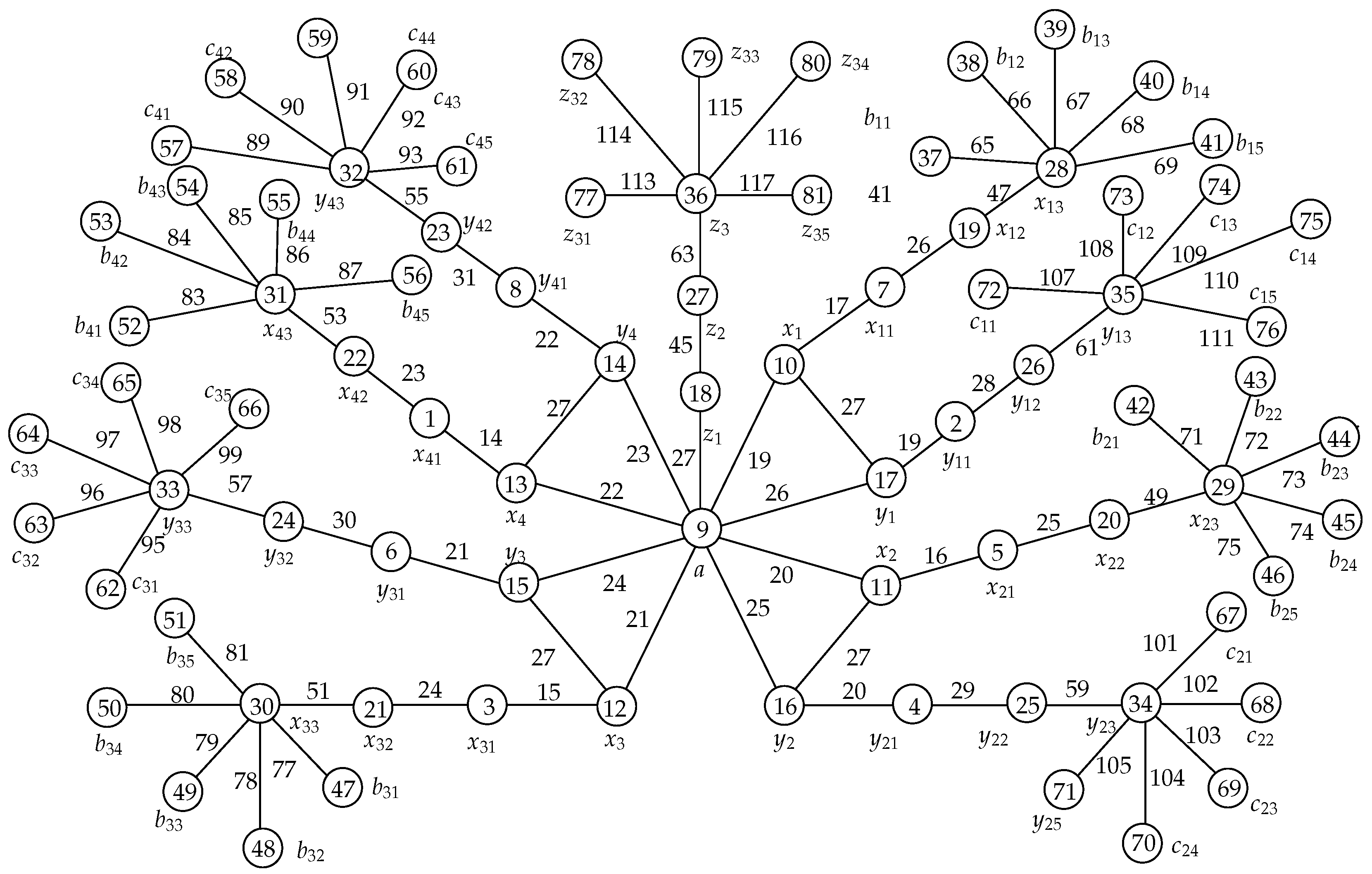1. Introduction
Let
G and
H be two connected graphs. Let
v be a vertex of graph
H. The comb product between graphs
G and
H, denoted by
, is a graph obtained by taking one copy of
G and
copies of
H and grafting the i-th copy of H at the vertex
v to the
i-th vertex of
G. In this study, the graph definition used is based on Chartrand et al. [
1].
The study of the graph in this research is focused on rainbow antimagic coloring, which is a combination of the concepts of antimagic labeling and rainbow coloring. Rainbow connection definitions can be found in [
2,
3]. Let
G be a connected graph, the edge coloring of
G with the function
is
k-coloring of graph
G, where adjacent edges can be colored with the same color. Rainbow
path is the path in
G if no two edges are the same color. The graph
G is a rainbow connection if every
has a rainbow path. The edge coloring on
G has a rainbow connection called rainbow coloring. The minimum colors to make
G rainbow-connected is called the rainbow connection number of
G and is denoted by
. Rainbow coloring is an interesting study and has found many results, including [
4,
5].
Rainbow vertex coloring and rainbow total coloring are other variants of rainbow coloring. Rainbow vertex coloring was introduced in [
6] and rainbow vertex coloring results can be found in [
7,
8]. Total rainbow coloring results can be seen in [
9,
10]. Wallis et al. [
11] introduced graph labeling. Hartsfield and Ringel [
12] introduced antimagic labeling. The antimagic labeling of graph
G is a bijective function of the edge set
to
and
, and
is the set of edges incident with the vertex
v for vertices
,
.
Antimagic labeling has had several results, including those of Baca et al. in [
13,
14,
15,
16]. Dafik et al. contributed to the antimagic labeling in [
17]. In addition, antimagic labeling results can also be found in [
18,
19]. The concept of combining graph labeling and graph coloring was initiated by Arumugam et al. [
20]. The bijective function from edge set
to
is
, and
is the set of edges that are incident to vertices
v, for every
The bijective function
f for two adjacent vertices
is called antimagic labeling. The coloring of the vertices on
G with the vertices of
v colored with
is the local antimagic label. If we consider the local antimagic labeling chromatic number, then it is called local antimagic coloring.
Motivated by the combination performed by Arumugam, in [
21], Dafik et al. took the initiative to combine the concepts of antimagic labeling and rainbow coloring on graphs into a new concept, namely, rainbow antimagic coloring. Septory et al. determined the lower bound of rainbow antimagic connection number for any connected graph.
Lemma 1 ([
22])
. Let G be any connected graph. Let and be the rainbow connection number of G and the maximum degree of G, respectively. . While Dafik et al., has two theorems about characterizing the existence of rainbow path of any graph of , the result of rainbow antimagic connection number of friendship graph and any tree is shown in the following Theorem.
Theorem 1 ([
21])
. Let G be a connected graph of diameter . Let f be any bijective function from to the set ; there exists a rainbow path. Theorem 2 ([
21])
. For , . Theorem 3 ([
21])
. For , being any tree of order , . Some other results about rainbow antimagic connection number can be found in [
21,
22,
23,
24]. In this paper, we will study the rainbow antimagic connection number of graph
where
is a friendship graph with order
and
, where
is the path graph of order
m,
is the star graph of order
,
is the broom graph of order
and
is the double star graph of order
.
2. Results
In this section, we will show our new results about rainbow antimagic connection number on those above graphs stated in a lemma and theorem. Our strategy is firstly determined with the lower bound rainbow antimagic connection number of . Finally, we show the exact values of , , and .
Lemma 2. Let be a comb product of friendship graph and be any tree of order . The lower bound of .
Proof of Lemma 2. Graph is the comb product of two graphs and , and o is the vertex of . Graph is obtained by taking one copy of and copies of and grafting o from the i-th copy of at the i-th vertex of . By this definition, it implies that graph contains graph and copies of graph . We can determine by finding and . Based on Theorem 2, we have . Based on Theorem 3, we have ; so, every edge of all i-th copies of has a different color. Thus, . □
Theorem 4. For , .
Proof of Theorem 4. Graph is a connected graph with vertex set and edge set . The cardinality of and the cardinality of .
To prove the rainbow antimagic connection number of , first, we have to show the lower bound of . Based on Lemma 2, we have rac . Since , .
Secondly, we have to show the upper bound of
. Define the vertex labeling
as follows:
The edge weights of the above vertex labeling
f can be presented as
It is easy to see that the above edge weight will induce a rainbow antimagic coloring of graph . Based on Theorem 3, ; since , the weight of each edge in graph is different. Therefore, the sum of the weights on copies of graph is . Based on the description above, we have that the distinct weight of graph is . It implies that the edge weights of induce a rainbow antimagic coloring of colors. Thus, . Comparing the two bounds, we have the exact value of .
The next step is to evaluate to prove the existence of a rainbow path . Based on the definition of graph , graph contains one graph and copies of ; so, we can evaluate the rainbow path of graph by evaluating the rainbow path on graph and graph . Since , based on Theorem 1, there is a rainbow path for every . Based on Theorem 3, ; since has edges, there is a rainbow path for every . Therefore, according to the explanation, it can be seen that there is a rainbow path for every . □
The illustration of a rainbow antimagic coloring of graph
can be seen in
Figure 1.
Theorem 5. For , .
Proof of Theorem 5. Graph is a connected graph with vertex set and edge set . The cardinality of and the cardinality of .
To prove the rainbow antimagic connection number of , first, we have to show the lower bound of . Based on Lemma 2, we have rac . Since , .
Secondly, we have to show the upper bound of
. Define the vertex labeling
as follows:
The edge weights of the above vertex labeling
f can be presented as
It is easy to see that the above edge weight will induce a rainbow antimagic coloring of graph . Based on Theorem 3, ; since , the weight of each edge in graph is different. Therefore, the sum of the weights on copies of graph is . Based on the description above, we have that the distinct weight of graph is . It implies that the edge weights of induce a rainbow antimagic coloring of colors. Thus, . Comparing the two bounds, we have the exact value of .
The next step is to evaluate to prove the existence of a rainbow path . Based on the definition of graph , graph contains one graph and copies of ; so, we can evaluate the rainbow path of graph by evaluating the rainbow path on graph and graph . Since , based on Theorem 1, there is a rainbow path for every . Based on Theorem 3, ; since has m edges, there is a rainbow path for every . Therefore, according to the explanation, it can be seen that there is a rainbow path for every . □
The illustration of a rainbow antimagic coloring of graph
can be seen in
Figure 2.
Theorem 6. For , .
Proof of Theorem 6. Graph is a connected graph with vertex set and edge set . The cardinality of and the cardinality of .
To prove the rainbow antimagic connection number of , first, we have to show the lower bound of . Based on Lemma 2, we have . Since , .
Secondly, we have to show the upper bound of
. Define the vertex labeling
as follows:
The edge weights of the above vertex labeling
f can be presented as
It is easy to see that the above edge weight will induce a rainbow antimagic coloring of graph . Based on Theorem 3, ; since , the weight of each edge in graph is different. Therefore, the sum of the weights on copies of graph is . Based on the description above, we have that the distinct weight of graph is . It implies that the edge weights of induce a rainbow antimagic coloring of colors. Thus, . Comparing the two bounds, we have the exact value of .
The next step is to evaluate to prove the existence of a rainbow path . Based on the definition of graph , graph contains one graph and copies of ; so, we can evaluate the rainbow path of graph by evaluating the rainbow path on graph and graph . Since , based on Theorem 1, there is a rainbow path for every . Based on Theorem 3, since has edges, there is a rainbow path for every . Therefore, according to the explanation, it can be seen that there is a rainbow path for every . □
The illustration of a rainbow antimagic coloring of graph
can be seen in
Figure 3.
Theorem 7. For , .
Proof of Theorem 7. Graph is a connected graph with vertex set and edge set . The cardinality of and the cardinality of . To prove the rainbow antimagic connection number of , first, we have to show the lower bound of . Based on Lemma 2, we have . Since , .
Secondly, we have to show the upper bound of
. Define the vertex labeling
as follows:
The edge weights of the above vertex labeling
f can be presented as
It is easy to see that the above edge weight will induce a rainbow antimagic coloring of graph . Based on Theorem 3, ; since , the weight of each edge in graph is different. Therefore, the sum of the weights on copies of graph is . Based on the description above, we have that the distinct weight of graph is . It implies that the edge weights of induce a rainbow antimagic coloring of colors. Thus, . Comparing the two bounds, we have the exact value of .
The next step is to evaluate to prove the existence of a rainbow path . Based on the definition of graph , graph contains one graph and copies of ; so, we can evaluate the rainbow path of graph by evaluating the rainbow path on graph and graph . Since , based on Theorem 1, there is a rainbow path for every . Based on Theorem 3, ; since has edges, there is a rainbow path for every . Therefore, according to the explanation, it can be seen that there is a rainbow path for every . □








